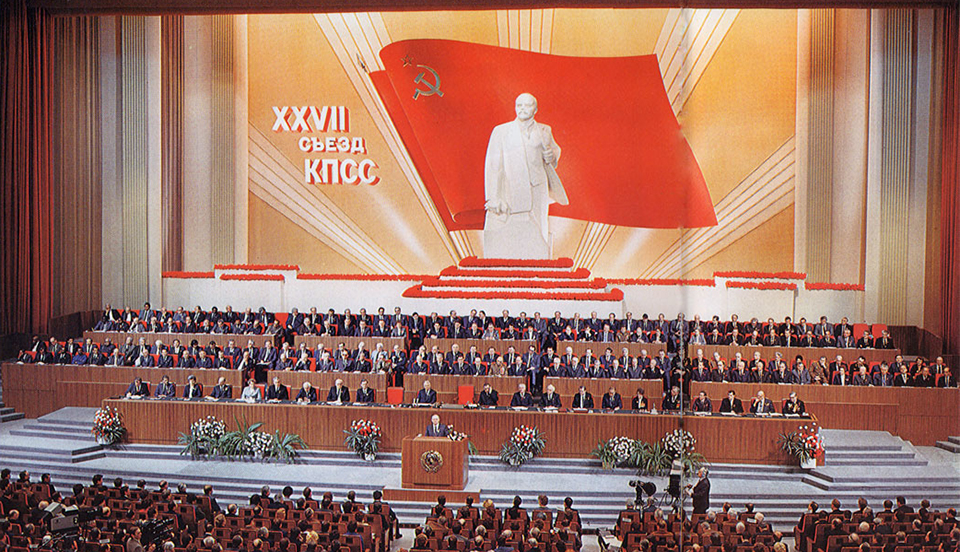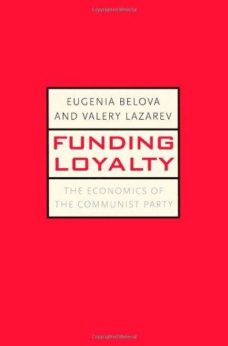
A lot has been written about the former Soviet Union and its governing party, the Communist Party. A lot more will likely be written, especially now during the 100th centennial of the Bolshevik Revolution.
However, to this author’s knowledge, none have taken the route of Eugenia Belova and Valery Lazarev’s Funding Loyalty: The Economics of the Communist Party.
Though a relatively short book, Funding Loyalty packs quite a wallop that consists of aspects of CPSU internal funding, leadership pay, and discipline not easily found elsewhere.
As the authors write in the introduction, “Budgets – or more broadly financial statements – do not immediately come to mind when a political institution such as the Communist Party of the Soviet Union is considered. Nevertheless, each year the CPSU had a budget – a carefully planned top-secret document – that allocated well-defined amounts across a specific range of expenditure items.”
Perhaps surprisingly, like in market economies, outside auditors examined the revenues and expenditures of the CPSU, made assessments, and proposed increases and/or cuts in spending priorities.

Additionally, while most other studies focus on “repressive” aspects, Belova and Lazarev focus on the “mechanisms of raising loyalty through a mass party,” a considerably different approach, and one that acknowledges and affirms the fact that the CPSU “was a large-scale [financial] political enterprise that required management, oversight, and ultimately funding.”
Further, and probably contrary to popular belief, the CPSU kept, managed, and oversaw “detailed information on revenues, expenditures, and state subsidies to the party system,” and it is this empirical information that the authors base their study on.
As the authors write, “The top party leadership took party money seriously.”
Interestingly, membership dues did not “play an important role in party finances prior to 1917 since the party was not a mass party…” It wasn’t until March 1919, after the consolidation of the party’s power, that dues became a requirement of membership, although they rarely constituted a majority of the Party’s overall finances.
By the Seventeenth Party Congress in 1934, “three short paragraphs” on party finances were articulated. First, “party funds were made up of membership dues, revenue of party enterprises, and other revenues; the second linked dues rates to monthly salaries; and the third introduced an admission fee.” These rules three rules, according to the authors, “remained largely unchanged through the end of the Soviet era.”
Also of note is the fact that the CPSU, from the 1960s onward, was almost entirely self-funding, receiving only marginal government assistance. As the authors write, “Abundant in the late 1930s, state subsidies to the party had faded by the mid-1960s, and self-generated revenue increased more than twofold, from some 40 percent to nearly 90 percent.”
In fact, by the late 1950s, “the party moved to financial autonomy, with its budget showing an accounting surplus. By 1990, it had accumulated a substantial ‘emergency fund.’”
Surprising to some, while “ideological services” – propaganda, party education, and training – “took over one-third of total party expenses” in 1938, but by the late 1950s, as the party became more self-sufficient, “ideological services” fell to “under 10 percent of the total expenditure.”
In short, as the party was forced to stand on its own two feet, it moved to prioritize more profitable endeavors, like publishing, and owning and leasing property. “From the late 1950s onward, nearly one-third of the CPSU revenue came from publishing” books, magazines, and newspapers and royalties.
One of the most interesting aspects of Funding Loyalty is a brief though insightful analysis in the section titled ‘The Promotion Contract And the Dynamics of Party Membership.’ In it, the authors postulate, based on the data at hand, that higher wages – and other forms of remuneration – among the party elite actually resulted in an increase in party membership.
As they write, “Bringing the demand and supply sides of the activist recruitment process together, we can formulate that higher inequality (lower wages and/or higher rents for the bosses), a larger number of boss positions, and higher capital investment will result, other things being equal, in greater increase in party membership.”
And, “The supply of activists, measured as the number of party candidates, is positively affected by the size of the income gap between the party bureaucracy and workers.”
This may seem astonishing to some, both from the right and left. However, from a purely economic standpoint, especially in economies of scarcity (which the Soviet Union was), it’s a logical assessment, as “party candidates” sought to better their lot by striving towards party leadership. In other words, careerism contextualized and interacted dialectically with the potential for party growth in the post-World War II Communist Party.
Belova and Lazarev also deal with the distinction between internal party discipline and external non-party punishment, which this review does not have the space to delve into, and which others have written about, notably Edward Cohn’s The High Title Of A Communist (reviewed here).
There are a lot of important observations in Funding Loyalty, observations we should consider seriously – primarily the analysis of the Communist Party’s emphasis on managing self-sustaining and profitable enterprises as opposed to on-going and unprofitable “ideological services,” as well as pay differentials resulting in increased membership dues, facts hardly lost on party leaders.
To their credit, Belova and Lazarev do a good job of simply presenting the information on hand, assessing its impact of CPSU financial policy positions, and testing their hypothesis against the actual results.
Funding Loyalty: The Economics of the Communist Party
By Eugenia Belova and Valery Lazarev
Yale University Press, 2012, 209 pages

MOST POPULAR TODAY

High Court essentially bans demonstrations, freedom of assembly in Deep South

Zionist organizations leading campaign to stop ceasefire resolutions in D.C. area

U.S. imperialism’s ‘ironclad’ support for Israel increases fascist danger at home

UN warns that Israel is still blocking humanitarian aid to Gaza







Comments